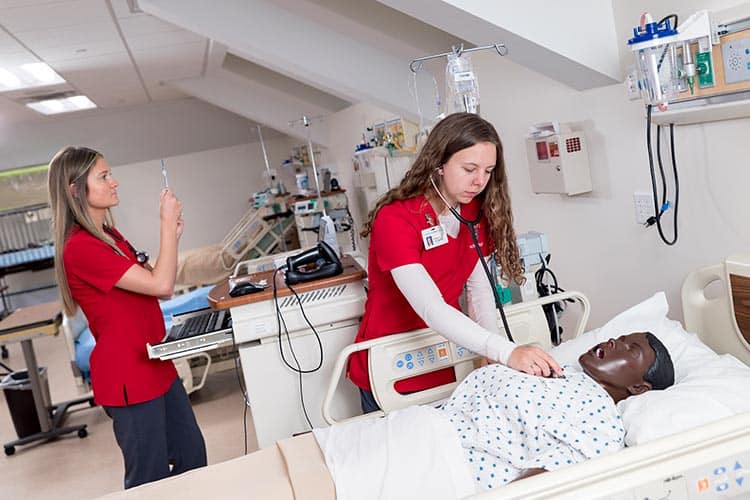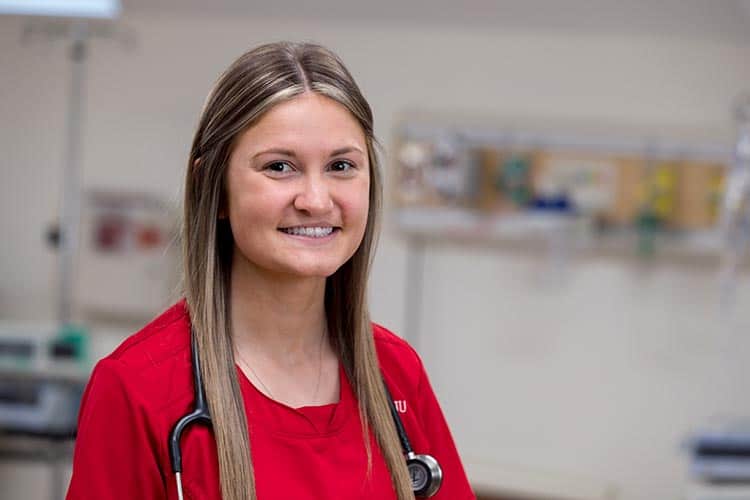The graduate nursing program at the College of Saint Benedict and Saint John’s University is expanding so fast it’s going to extend to a select group of undergraduates beginning in the fall.
CSB and SJU launched two doctorate programs in 2021, one as a route to become a family nurse practitioner, the other a leadership track. Beginning with the fall semester, coursework toward a new Master of Science in Nursing (leadership and education for practice) will begin – including the first cohort of seniors who will accelerate their post-graduate studies by a full year.
Application for the new 4+1 BSN-MSN was first offered this spring to “ambitious” juniors to save time and money toward an education they were perhaps going to get anyway – and ultimately may need in today’s job market.
It’s intended for an elite group of students who must pass a rigorous application process to get the opportunity – sort of a Top Gun program for nursing. A grade-point average of at least 3.4 is required to even start the conversation.
“When we look at this program, we’re selective,” said Jennifer Peterson, DNP, FNP-C, APRN, CNOR, the CSB graduate nursing program chair, who developed the concept with Professor Carrie Hoover, PhD, RN. “There’s criteria the students have to meet to be eligible, but then we evaluate them in other ways once we get their application. We talk with their adviser and the faculty they have in their courses to ensure they are motivated and have the skills necessary to take graduate courses during their senior year. Some of those faculty will be the same ones teaching the graduate level courses. We want to make sure the students are successful.”
Program saves about $9,000 in tuition
There will be five students in the first 4+1 BSN-MSN cohort. Peterson said depending on interest and ability, the program will support between 6-10 students each year. The primary benefits are to save a year of graduate school and the approximate $9,000 difference in the cost of credits to take that year as an undergraduate.
That sounds great to Faith Bergeman and Kaitlyn Sanstead, both CSB juniors, who will be in the initial cohort. Bergeman grew up in Madelia, Minnesota, and wants to be a nurse anesthetist. Sanstead, who is from Hoffman, Minnesota, wants to become a midwife or nurse practitioner. They’re roommates who push each other academically, and they’ll need that in the year ahead because there is no reduction in requirements for the 4+1 BSN-MSN program. But with the 600 hours of extra clinical practicum they will experience, one-on-one with a preceptor in a hospital setting, will pay off.
“For the careers we want to go into, typically you have to have a couple of years’ experience,” Bergeman said. “This is going to give us a jump-start on that and exposure to more critical care.”
Bergeman said she’s known she wants to work in medicine as long as she can remember. She was born with a cleft lip and underwent nearly a dozen different surgeries.

Faith Bergeman (left) and Kaitlyn Sanstead work in the nursing lab in the Main Building at the College of Saint Benedict. The two junior nursing majors will be part of the first cohort in a new 4+1 BSN-MSN program in the fall of 2022 that will allow elite and motivated students to take a year of graduate school while they finish the senior year of their undergraduate degree. The option will save time and money for prospective students who want to get a master’s degree in nursing.
“I’ve been exposed to a lot of the inpatient settings for basically my whole life,” she said. “Along the way, I decided I want to help people just like they helped me. I can distinguish between bad care and good care, and I want people to have the good care that I did. I’ve shadowed nurses and physicians and eventually I realized the nurses were the ones providing more of the bedside care. That’s what I want to do.”
Allows undergrads to take their education farther, faster
Sanstead always knew she wanted to be a nurse and to take her education farther, in a capacity that would center on women and families. Recently as part of a class, she read “Waiting with Gabriel,” a book written by Amy Kuebelbeck ’86, who is originally from St. Joseph, Minnesota, and went to graduate school at the University of Minnesota. Hers is the true story of parents who were told that their unborn baby had an incurable heart condition, confronting them with an impossible decision: to attempt risky surgeries to give their baby a chance at a longer life, or to continue the pregnancy and embrace their baby’s life as it would unfold, from conception to natural death.
“It’s about a little boy and, when he was born, he only lived for about two hours,” Sanstead said. “It wasn’t until I read that book that I decided ‘Wow. I want to be with mothers throughout the whole process, not just the birth.’ Seeing how the nurses and health care providers reacted and helped during that situation really sparked my interest.”
Peterson said the 4+1 BSN-MSN was really Hoover’s idea, and that for new graduating nurses a master’s degree can be necessary for the roles some will undertake.
“What we’ve seen, especially since COVID-19, is that some of our graduates go into their first job, and they start working on the unit,” Peterson said. “But within a year, they’re in a leadership role – perhaps as a charge nurse. There are skills you need to be successful in those roles. That’s where this master’s program comes in. It provides that extra level of training so they have more confidence, not only in their clinical practice but also in their leadership and education skills. They can educate staff and patients. It makes them more well-rounded and prepared for these roles that they’ll probably be going into.”
The MSN will provide additional clinical practice, leadership and education. During their senior year, students like Bergeman and Sanstead will do an additional clinical rotation in addition to the one all senior undergraduates complete as a capstone experience, akin to an internship. When they get to the spring semester of their senior year, they’ll take an ethics and health policy course, an organizational leadership course, and another on global perspectives. Those build the foundation of the graduate program. The ethics course replaces the undergraduate ethics course and is taught at a higher level. The graduate courses also are taught in a hybrid format, allowing for both online and residential components.
Nurses in demand, young grads pushed into leadership roles
All CSB and SJU nursing graduates are in demand, and those who acquire the MSN will be especially so. According to the Minnesota Department of Employment and Economic Development (DEED), “registered nurse” was the most in-demand job in the state in 2021 with 3,203 openings. The wage for these positions ranges from $32.66 to $45.62 per hour.
In recent months, the combination of COVID-19 and the workforce shortage conspired to make it necessary for some health care institutions to use assistance from the National Guard. Nearly 1 in 5 health care workers quit their jobs during the pandemic, another 31% have considered it, and 80% say they’ve been impacted by the personnel shortages. Burnout has caused many nurses to retire early or quit the profession altogether. Of the 118,000 RNs in 2021, more than 17% said they will retire within five years, according to the Minnesota Board of Nursing.
The CSB+SJU pass rate for the National Council Licensure Exam for registered nurses is 94%. Peterson said the job placement rate is close to 100%. Through 2020, the only institutions in Minnesota with entry-level MSN programs were the University of Minnesota in Minneapolis and St. Catherine University and Metropolitan State University, both in St. Paul.
“It’s perhaps between 1 in 4 and 1 in 5 of our undergraduate students that go on to graduate level degrees at some point,” Peterson said. “Our students have a very strong network to the college. We want to give them the opportunity to come back to this community that they love. And, with the 4+1 option, it was a way for some to start that process sooner.”
The typical MSN entry is between 30-31 years of age and, according to the Minnesota Department of Health Workforce Data Portal, 10% of RNs have an MSN and 2% achieved their doctorate.
Soon, Bergeman, Sanstead and their peers could join those ranks. They know the training won’t be easy, but to be their best they want to be pushed among the best.
“It hasn’t really sunk in yet,” Sanstead said. “It probably won’t until we start the classes.”

Faith Bergeman

Kaitlyn Sanstead
